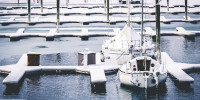How to Winterize Your Sailboat Cheaper & Quicker
Winterizing your sailboat takes anywhere from a few hours to a full day. It can also be costly due to its size and the added components of the boat. Fortunately, in this article, we have rounded up ways to winterize your sailboat cheaper and quicker without compromising on quality or safety.
One of the best ways to save money on winterizing your sailboat is by doing it yourself. You can learn by following online tutorials or reading books on the subject. To save time, you can make a checklist of things you need to complete and use a winterizing kit.
Another way to winterize your sailboat cheaper and quicker is by shopping around for the best deals on supplies and services. You can compare prices from different marinas and boatyards to find the most affordable options. Let's look at some other cost-saving and time-saving options below.
Summary
- The cost of professional boat winterization can be up to $700, but doing it yourself can only cost as little as $50–$100.
- The price of a winterization kit from Amazon costs only around $29.99, but buying the same one from West Marine costs around $89.99.
- Instead of expensive antifreeze, you can use non-toxic propylene glycol, which is 50% less expensive than the former.
- Regularly clean your sailboat to prevent the buildup of dirt and grime, which can make winterizing more difficult and time-consuming.
- When choosing a cover for your sailboat, choose one that is durable, waterproof, and fits your sailboat snugly to prevent wind from getting underneath it.

On this page:
Cost-Saving Tips For Winterizing Your Sailboat
Winterizing your sailboat can be expensive, but there are ways to save money and still protect your boat from the harsh winter weather, such as the following:
Do it yourself
One of the best ways to save money on winterizing your sailboat is to do it yourself. The table below shows a comparison between DIY and professional winterization costs:
| Cost Component | DIY | Professional |
|---|---|---|
| Labor | $0 (assuming you do it yourself) | $300-$500 (depending on location and size of boat) |
| Materials | $50-$100 (antifreeze, oil, fuel stabilizer, etc.) | $100-$200 (same materials as DIY) |
| Total cost | $50-$100 | $400-$700 |
There are many resources available online that can guide you through the process step-by-step. These resources can include instructional videos, blog posts, and articles that provide detailed information on the different aspects of winterizing your boat.
Shop around for materials
The table below shows a comparison of the prices of boat winterization kits from different stores:
| Shop | Winterization Kit | Price |
|---|---|---|
| West Marine | Boat winterizer kit | $89.99 |
| Amazon | Camco Do It Yourself boat winterizer | $29.99 |
| Walmart | Star Brite boat winterizing kit | $39.99 |
When it comes to purchasing materials for winterizing your sailboat, it pays to shop around. You can compare prices at different stores and online retailers to find the best deals. You may also want to consider buying in bulk to save even more money.
Use alternative materials
The table below shows a list of alternative and cheaper materials you can use as substitute to some of the most commonly used materials when winterizing a boat:
| Material | Alternative | Estimated Cost Savings |
|---|---|---|
| Expensive antifreeze | Non-toxic propylene glycol | Up to 50% less expensive |
| Shrink wrap | Bubble wrap or old blankets | Up to 75% less expensive |
| Specialized boat cover | Tarp or heavy-duty plastic sheeting | Up to 60% less expensive |
| Commercial hull cleaner | Vinegar and baking soda | Up to 80% less expensive |
| Marine-grade wax | Automotive wax | Up to 50% less expensive |
| Specialty cleaning products | Mild soap and water | Up to 90% less expensive |
| Marine-grade paint | High-quality exterior paint | Up to 70% less expensive |
| Marine-grade sealant | High-quality silicone sealant | Up to 60% less expensive |
| Specialized marine-grade hardware | Stainless steel hardware from a hardware store | Up to 50% less expensive |
| Marine-grade electrical components | High-quality electrical components from an electronics store | Up to 40% less expensive |
You don't have to use expensive, specialized materials to winterize your sailboat. For example, instead of using expensive antifreeze, you can use non-toxic propylene glycol. You can also use bubble wrap or old blankets to insulate your boat instead of expensive shrink wrap.
If you're looking for alternatives to marine antifreeze, you might want to check out this article.
Share resources with other boaters
Perhaps you can also consider sharing resources with other boaters to save money on winterizing your sailboat. For example, you can split the cost of renting a storage unit or purchasing materials in bulk. You can also share knowledge and skills with other boaters to help each other save money.

Plan ahead
Don't wait until the last minute to start the process. Instead, start early and take your time to find the best deals on materials and labor. This will give you more time to research and compare prices, which can save you a significant amount of money in the long run.
Time-Saving Techniques For Winterizing Your Sailboat
While you can save money by doing the winterization process on your own, it can be a time-consuming task. On average, sailboats of up to 30 feet need 4-6 hours to complete winterization. To make it quicker, you can follow some of these techniques:
Make a checklist
Before you start winterizing your sailboat, make a checklist of all the tasks you need to complete. This will help you stay organized and ensure that you don't forget anything.
You can use a spreadsheet or a simple pen and paper to create your checklist. You can also include tasks like draining the water tanks, removing the sails, and adding antifreeze to the engine.

The Complete Checklist for Winterizing Your Boat (Free PDF)
Use a winterizing kit
Using a winterizing kit can help you save time and money. These kits typically include everything you need to winterize your sailboat, including antifreeze, fogging oil, and fuel stabilizer. They also come with instructions, which can be helpful if you're new to winterizing your sailboat.
Keep your sailboat clean
By regularly cleaning your sailboat, you can prevent the buildup of dirt and grime, which can make winterizing more difficult. You can also use a pressure washer to clean the bottom of your sailboat, which can help prevent the growth of barnacles and other marine life.
Store your sailboat properly
Try to store your sailboat in a dry, covered area to prevent damage from the elements. You can also use a boat cover to protect your sailboat from the sun and rain.
If you want to save time and avoid the hassle of doing things by yourself, you can just find affordable marinas that offer boat winterization such as the ones in this article.
Step-By-Step Guide To Winterizing Your Sailboat

Winterizing your sailboat is an essential task to ensure its longevity and protection during the colder months. Here is a step-by-step guide to winterizing your sailboat cheaper and quicker.
Conduct a thorough inspection of your sailboat
You may want to check for any damages, leaks, or cracks in the hull, deck, and rigging. Inspect the sails, lines, and furling systems for any signs of wear and tear.
Check also if the boat's electrical systems are in working order, and the batteries are fully charged. You can make a list of all the necessary repairs and replacements.
Prepare the hull and deck
Here are some tips to prepare these two essential parts for the winter season:
Clean your hull and deck thoroughly
Remove any dirt, grime, and salt residue that may have accumulated during the sailing season. You can use a pressure washer or a sponge and soap to clean the surfaces.
Apply wax or polish to the hull and deck
Waxing and polishing not only make your sailboat look good, but they also protect the surfaces from the harsh winter elements. You can use a marine-grade wax or polish to ensure maximum protection.
Repaint as needed
If your sailboat's hull or deck needs repainting, now is the best time to do it. Repainting can be costly, but it's a necessary investment to protect your sailboat from the harsh winter elements. You can either hire a professional to do it or do it yourself if you have the skills and equipment.
Cover your sailboat to protect it from the winter elements
There are several options when it comes to covering your sailboat, and each has its own advantages and disadvantages.
| Option | Advantages | Disadvantages |
|---|---|---|
| Boat cover | Affordable, easy to use, available in different sizes and materials. | May not provide as much protection as other options. |
| Shrink wrap | Provides a tight fit and helps prevent snow and debris accumulation. | Expensive, time-consuming, harmful to the environment if not disposed of properly. |
| DIY covers | Cost-effective and customizable. | May not be as durable or provide as much protection as professionally made covers. Requires sewing skills and equipment. |
When choosing a cover for your sailboat, consider the following tips:
- Choose a cover that is made of durable and waterproof material.
- Make sure the cover fits your sailboat snugly to prevent wind from getting underneath it.
- Consider investing in a cover support system to prevent water from pooling on top of the cover.
- Remove any loose items from your sailboat before covering it to prevent damage to the cover.
Drain and flush the water system
Start by draining all the water from your boat's fresh water system. This includes the water tanks, pipes, and hoses. You can do this by opening all the taps on the boat, hot and cold, and letting them run until the water tank is empty.

How To Clean Your Boat's Freshwater Tank (Plastic & Aluminum)
Next, you need to protect your boat's plumbing system from freezing temperatures. You can do this by either using antifreeze or blowing out the system with compressed air.

If you choose to use antifreeze, make sure to use non-toxic, plumbers antifreeze. Pour the antifreeze into the water tank, turn on the pump, and let it run until the pink antifreeze comes through the taps.
If you choose to blow out the system with compressed air, you need to make sure that all the water is removed from the system. This can be done by using an air compressor and blowing air through the system until all the water is removed.
Close all seacocks and valves to prevent water from entering the system. Additionally, don't forget to winterize your boat's toilet. You can do this by pumping non-toxic antifreeze through the toilet until it comes out clear.
Winterizing the electrical system
Remove the batteries
Removing the batteries help prevent them from freezing and potentially cracking. Once you have removed the batteries, you should clean them and store them in a cool, dry place. You can also use a battery tender to keep them charged and in good condition throughout the winter.
Check and clean all of the electrical connections
Over time, these connections can become corroded and loose, which can lead to problems when you try to start your boat in the spring. Take the time to inspect all of the connections and clean them as necessary.
Protect the engine and fuel system
Drain the fuel tanks and add a fuel stabilizer to prevent any moisture buildup. Change the oil and oil filter and fog the engine to prevent rust and corrosion.
Old oil can cause damage to the engine block over time, so have the time to replace it. Additionally, it's a good idea to add a fuel stabilizer to the fuel system to prevent the fuel from breaking down and clogging the fuel filters. Check the coolant and add antifreeze if necessary.
Removing and storing sails and masts
Proper care for the sails
-
Clean your sails thoroughly before storing them for the winter. Use a mild soap and water solution to remove any dirt, salt, or other debris. Rinse them well and allow them to dry completely before folding and storing them.
-
Inspect your sails for damage before storing them. Look for any tears, holes, or other signs of wear and tear. If you find any damage, have it repaired before storing the sails.
-
Store your sails in a dry, cool place. Avoid storing them in direct sunlight or in a damp area, as this can cause mildew and other damage.
-
Perhaps try using a sail cover to protect your sails from UV damage and other environmental factors.
Proper care for the mast
-
Inspect your mast for any signs of damage before storing it for the winter. Look for cracks, corrosion, or other signs of wear and tear.
-
Clean your mast thoroughly before storing it. Use a mild soap and water solution to remove any dirt, salt, or other debris. Rinse it well and allow it to dry completely before storing it.
-
Consider removing your mast for the winter if you live in an area with harsh winter weather. This can help protect it from damage caused by heavy snow or ice.
-
If you leave your mast up, make sure to inspect it regularly throughout the winter for any signs of damage or wear and tear.
Cleaning and Protecting the Interior and Exterior of Your Sailboat
Here are a few tips to help you winterize the cabin of your sailboat cheaper and quicker:
Clean the interior
Remove any dirt, dust, or debris from the interior. Vacuum and wipe down all surfaces, including the floors, walls, and ceiling. Don't forget to clean the windows and hatches, too.
Remove moisture and prevent mildew
To prevent mildew and other moisture-related issues, you might want to consider using a dehumidifier or moisture absorber. You can also leave a few bags of charcoal or kitty litter in the cabin to help absorb moisture.
Protect your upholstery
To protect your upholstery during the winter months, try covering it with plastic or a tarp. This will help prevent dust and other debris from settling on your upholstery. You can also use a fabric protector to help repel water and stains.

Store your belongings
Before you leave your sailboat for the winter, make sure to store all of your belongings in a safe, dry place. This includes everything from bedding and clothing to kitchenware and electronics. You can use plastic bins or vacuum-sealed bags to protect your belongings from moisture and dust.
Check for leaks
Look for water stains on the ceiling and walls, and check the windows and hatches for signs of water infiltration. If you do find a leak, make sure to fix it before you leave your sailboat for the winter.
Secure your sailboat for winter storage
Ensure that the boat is properly secured to the dock or the mooring. Remove any loose items from the boat, including cushions, life jackets, and ropes. Install a dehumidifier to prevent any moisture buildup.
Did you find the answer to your specific question?
👍 0 👎 0




Leave a comment